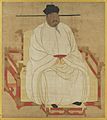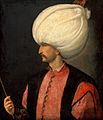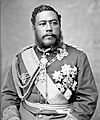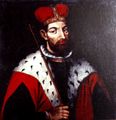Royal house facts for kids
A royal house or royal dynasty is like a special family name for royalty. It includes all the members of a royal family, both old and young, who are related to each other. Many royal families around the world don't use a regular family name. Instead, they are known by their titles, which often relate to the land they rule or once ruled. Royal houses are still around today in many countries.
Contents
What Are Royal Houses?
A royal house is basically the family that rules a country, or used to rule it. Think of it as a very old and important family tree. When we talk about a royal house, we are talking about a group of people who are related by blood or marriage. They share a common ancestor and often have a special name for their family, like the House of Windsor in the United Kingdom.
How Royal Houses Get Their Names
Sometimes, a royal house gets its name from a famous ancestor. Other times, it's named after a place they were important to. For example, the House of Bourbon is a famous royal house that ruled in France and other countries. Their name comes from a region in France.
Why Royal Houses Are Important
Royal houses have played a huge role in history. They have led countries, made laws, and shaped cultures for hundreds of years. Even today, in countries with monarchies, the royal house often represents the nation and its traditions. They might not have political power, but they are important symbols.
Royal Houses That No Longer Rule
Many royal families once ruled countries but no longer do. These are called "deposed" or "extinct" royal houses. "Deposed" means they were removed from power, often because the country became a republic (where people elect their leaders). "Extinct" means the family line has ended, and there are no more direct descendants to take the throne.
From Kingdoms to Republics
Most nations that were once ruled by royal houses are now republics. This means they have a president or other elected officials instead of a king or queen. For example, France used to be ruled by kings from the House of Bourbon, but now it's a republic. Germany also had many princely houses that ruled different states, but these states are now part of the German Republic.
Famous Royal Houses That Ended Their Rule
Many powerful royal houses from history no longer rule. The Qing dynasty was the last imperial dynasty of China. It ruled for centuries before China became a republic in 1912. The House of Romanov ruled Russia for a long time, with famous rulers like Peter the Great. However, their rule ended in 1917. These families left a big mark on history, even though they don't hold power today.
Images for kids
-
The Qing dynasty was the final imperial dynasty of China. It was established in 1636 and collapsed in 1912.
-
Karikala, the Tamil King of Early Cholas, who built the ancient Kallanai Dam.
-
Zhao Kuangyin (Emperor Taizu of Song) was the founder of the Song Dynasty in China.
-
Zhu Yuanzhang (Hongwu Emperor) was the founder of the Ming dynasty in China.
-
Babur, from the Timurid dynasty, was the first ruler of the Mughal Empire in India.
-
Suleiman the Magnificent, from the House of Osman, was the longest-reigning Sultan of the Ottoman Empire, ruling from 1520 until 1566.
-
Muhammad Ali Pasha, founder of the Muhammad Ali dynasty, ruled Egypt and Sudan from 1805 to 1848.
-
Mohammad Reza Pahlavi, from the Pahlavi dynasty, was the last Shah of Iran, before the Iranian Revolution.
-
Peter I, from the House of Romanov, was the first Russian monarch to rule as Emperor.
-
Constantine XI Palaiologos, from the Palaiologos Dynasty, was the final monarch of the Byzantine Empire.
-
Pedro II, from the House of Braganza, ruled Brazil from 1831 to 1889.
-
Kalākaua, founder of the House of Kalākaua, was the penultimate sovereign ruler of the Hawaiian Kingdom.
-
Asahito (Emperor Higashiyama), from the House of Yamato, was the 113th Japanese Emperor.
-
Emperor Meiji, from the House of Yamato, was the 122nd Japanese Emperor.
-
Christian I, from the House of Oldenburg, served as King of Denmark, Norway and Sweden.
-
Aisin Gioro Xuanye (Kangxi Emperor), of the Qing dynasty, was the longest reigning Emperor of China.
-
Mohammad Shah Qajar, from the Qajar dynasty, was King of Persia.
-
Yi Seong-gye (Taejo of Joseon) ruled Korea from 1392 to 1398, as the first King of the Joseon Dynasty.
-
Nikola I, from the Petrović-Njegoš dynasty, ruled Montenegro from 1860 to 1918.
-
Nguyễn Phúc Bửu Lân (Emperor Thành Thái), from the Nguyễn dynasty, was Emperor of Vietnam from 1889 to 1907.
-
Ahmad al-Mansur, from the Saadi Dynasty, was the Sultan of Morocco from 1578 to 1603.
-
Louis XIV, from the House of Bourbon, reigned as King of France from 1643 to 1715.
-
Napoleon I, from the House of Bonaparte, ruled over France and Italy.
-
Thibaw Min was the last monarch of the Konbaung dynasty in Myanmar.
-
Henry VIII, from the House of Tudor, reigned as King of England and Ireland from 1509 to 1547.
-
Edward VI, from the House of Tudor, reigned as King of England and Ireland from 1547 to 1553.
-
Elizabeth I, from the House of Tudor, reigned as Queen of England and Ireland from 1558 to 1603.
-
Ranavalona I, from the Hova Dynasty, was Queen Regnant of Madagascar from 1828 to 1861.
-
Shō Tai, from the Second Shō dynasty, was the final sovereign ruler of the Ryukyu Kingdom.
-
Wanyan Aguda (Emperor Taizu of Jin) was the progenitor of the Jin Dynasty in China.
-
Trần Thuyên (Emperor Trần Anh Tông), from the Trần dynasty, ruled Vietnam from 1293 to 1314.
-
Otto I, from the House of Wittelsbach, was King of Greece from 1832 to 1862.
-
Tamar from the Bagrationi dynasty, was Queen Regnant of Georgia.
-
Khayishan (Külüg Khan and Emperor Wuzong of Yuan) was the seventh Khagan of the Mongol Empire and the third Emperor of the Yuan dynasty in China.
-
Agustín I was the first and only Mexican Emperor from the House of Iturbide.
-
Sigismund III from the House of Vasa, was monarch of Poland, Lithuania, Sweden and Finland.
-
Leopold I, from the House of Habsburg, was Emperor of the Holy Roman Empire, and King of Hungary, Croatia and Bohemia.
-
Wang Jeon (King Gongmin) ruled Korea from 1351 to 1374 as King of Goryeo.
-
Frederick the Great, from the House of Hohenzollern, was the King of Prussia from 1740 to 1786.
-
Wilhelm I, from the House of Hohenzollern, was the first German Emperor.
-
Victor Emmanuel II, from the House of Savoy, was the first King of Italy.
See also
In Spanish: Dinastía para niños














































